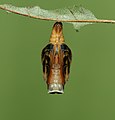
Ariadne merione, the common castor, is an orange butterfly with brown lines whose larvae feed almost exclusively on castor. It is similar in appearance to Ariadne ariadne, the angled castor.
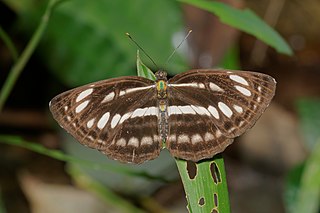
Neptis hylas, the common sailor, is a species of nymphalid butterfly found in the Indian subcontinent and southeast Asia. It has a characteristic stiff gliding flight achieved by short and shallow wingbeats just above the horizontal.

Luthrodes pandava also called the Plains Cupid or cycad blue, is a species of lycaenid butterfly found in South Asia, Myanmar, United Arab Emirates, Indochina, Peninsular Malaysia, Singapore, Taiwan, Java, Sumatra and the Philippines. They are among the few butterflies that breed on cycads, known for their leaves being toxic to most vertebrates.

Athyma selenophora, the staff sergeant, is a species of nymphalid butterfly found in tropical and subtropical Asia.

Zemeros flegyas, the Punchinello, is a small butterfly found in South Asia and Southeast Asia that belongs to the family Riodinidae.
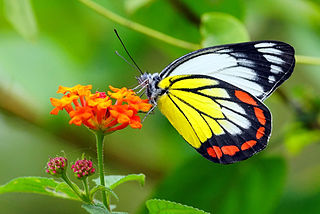
Delias hyparete, the painted Jezebel, is a medium-sized butterfly of the family Pieridae, found in South Asia and Southeast Asia.

Delias pasithoe, the redbase Jezebel is a medium-sized butterfly of the family Pieridae, that is, the yellows and whites. The species is found in parts of South Asia and Southeast Asia. There has been some dispute for which species the specific name aglaja, used twice by Linnaeus in 1758, applies – the redbase Jezebel, or the dark green fritillary, a brush-footed butterfly. Here, Delias pasithoe is used for the redbase Jezebel, based on the replacement name proposed by Linnaeus himself.
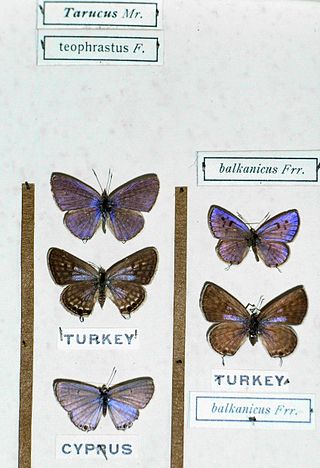
Tarucus theophrastus, the common tiger blue, pointed Pierrot or African Pierrot, is a small butterfly found in the Old World tropics. It belongs to the lycaenids or blues family.
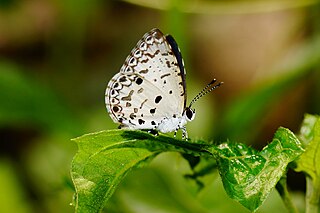
Megisba malaya, the Malayan, is a small species of butterfly found in South Asia and Southeast Asia. It belongs to the family of gossamer-winged butterflies (Lycaenidae). The species was first described by Thomas Horsfield in 1928.

Hypolimnas misippus, the Danaid eggfly, mimic, or diadem, is a widespread species of nymphalid butterfly. It is well known for polymorphism and mimicry. Males are blackish with distinctive white spots that are fringed in blue. Females are in multiple forms that include male-like forms while others closely resemble the toxic butterflies Danaus chrysippus and Danaus plexippus.

Neptis columella, the short banded sailer, is a species of nymphalid butterfly found in South and Southeast Asia.

Symbrenthia lilaea, the peninsular jester, is a species of nymphalid butterfly found in South Asia and Southeast Asia. It forms a superspecies with Symbrenthia hippoclus. There are numerous regional forms in a poorly resolved taxonomy.
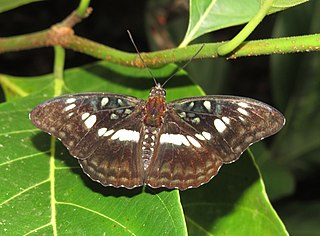
Athyma ranga, the blackvein sergeant, is a species of nymphalid butterfly found in south-west India, Cambodia and parts of Southeast Asia.
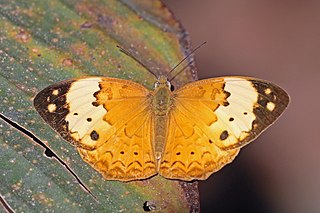
Cupha erymanthis, the rustic, is a species of brush-footed butterfly found in forested areas of tropical South Asia and Southeast Asia. The males and females are identical.
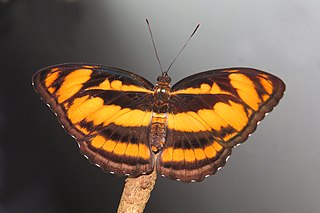
Athyma nefte, the colour sergeant, is a species of brush-footed butterfly found in tropical South and Southeast Asia.

Athyma zeroca, the small staff sergeant, is a species of nymphalid butterfly found in tropical and subtropical Asia.
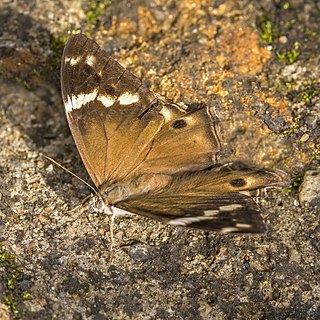
Lethe drypetis, the Tamil treebrown, is a species of Satyrinae butterfly found in south India and Sri Lanka.

Vindula erota, the common cruiser, is a species of nymphalid butterfly found in forested areas of tropical South Asia and Southeast Asia.

The Indian fritillary is a species of butterfly of the nymphalid or brush-footed family. It is usually found from south and southeast Asia to Australia.

Pantoporia hordonia, the common lascar, is a species of nymphalid butterfly found in Cambodia, tropical and subtropical Asia.




